Bees, Combs, and Fans:
Pictographs in the Palm of Your Hand
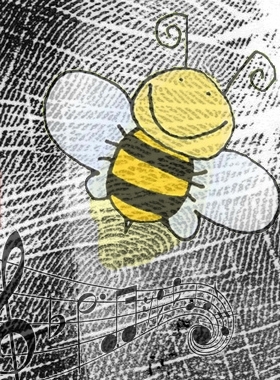
The “Musical Bee” is the most familiar of the dermatoglyphic configurations referred to as a vestige. The complete formation consists of two loops coming in from two different directions and the ridges between them as they meet to form an enclosed elliptical shape, the bee. In the print below it can be seen spread across the Mounts of Mars and Venus or the entire thenar mount. Within this enclosure the ridges appear like stripes on a bee against the ridges on either side. When the pattern is complete with all three sections it has been called The Musical Bee. This is because it is commonly found on people who have a special interest or gift for music. Although this is mainly anecdotal at this point, there does seem to be validity behind the label. Natural rhythm and timing are also associated with features of the knuckles of the thumb and the flow of the ridges across the mount.
The palms and soles are entirely covered with fields of ridges. Along with creases breaking into the open fields of ridges, are found configurations called patterns (also known as singularities). These include loops, various whorls, tented arches and the triradii. Commonly found within the patterns and open fields are odd disturbances, unique formations, or incomplete patterns. These are called vestiges.
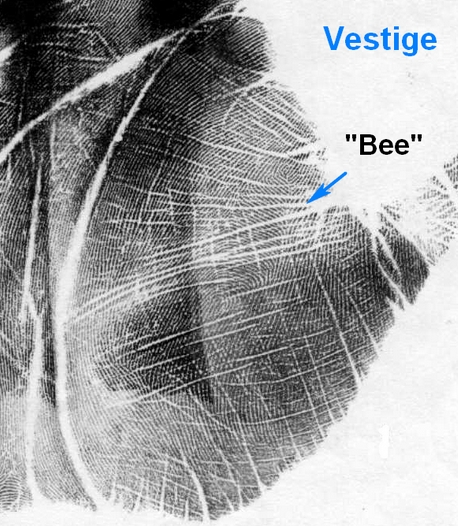
The term vestige represents the suggestion of something in the process of appearing or disappearing, or only a remnant of the whole pattern. Vestiges in the ridges can be found in several stages of development ranging from an obvious disturbance in a localized group of ridges, disarranged ridges, and rapidly converging ridges – to more complete shapes like this bee, combs, columns, and small fans. Patterns tend to form on the pads of the palms and fingertips. These are called volar pads, particularly in terms of developmental aspects. The ridges, in their formation, flow across the surface of the palms (and soles) based on guidelines that include genetic coding, environmental aspects, plus the shape and condition of the surface they are forming upon. Speed, order, and timing are key factors in the resulting patterns. Surfaces change during development, so that if (for example) an aspect is forming slowly due to environmental circumstances, yet the coding is set up for a particular pattern, that pattern will attempt to form on the surface at hand. If the surface isn’t designed or ready for such a formation, a vestige of the formation may appear.
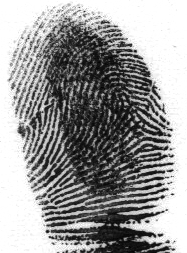
“Vestiges are conspicuous local disarrangements of ridges, not conforming to the definition of a true pattern, but suggesting an approach toward the construction of a pattern. A vestige may be a group of sharply converging ridges, ellipsoidal in shape if convergences occur in both extremities, or a group of straight parallel ridges forming a distinctive field within a zone of ridges of different course.” – Cummins & Midlo “Finger Prints Palms & Soles”
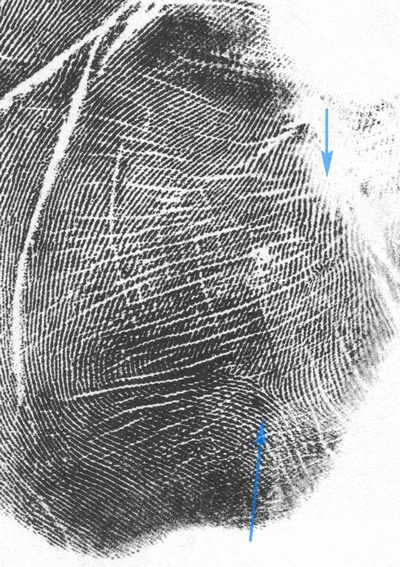 The natural flow of ridges across the thenar mount typically appear in what is called an Open Field. They simply flow around the ball of the thumb in a big general curve. This would indicate that at the time ridges were developing, the surface was smooth. More complex patterns form on raised mounts and inside indentations and dimples.
The natural flow of ridges across the thenar mount typically appear in what is called an Open Field. They simply flow around the ball of the thumb in a big general curve. This would indicate that at the time ridges were developing, the surface was smooth. More complex patterns form on raised mounts and inside indentations and dimples.
In the example on the right you can see the general flow of the ridges form a chevron shape. This is another feature that relates to music and dance, and especially to rhythm and timing.
The blue arrows point to two different types of vestiges. The lower arrow points to a pattern where the ridges meet at a sharp angle to each other forming what is commonly called a Comb. Likely because of its length it has also been recently labelled as a Column by some researchers in this field as shown in the screensave below. Valuable information, you’ll notice. Click on image to enlarge.
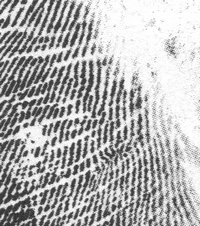
The upper arrow points to a different type of vestige. This feature has the appearance of a loop, but on closer look there are no real details of a loop. This is a vestige of a loop, or to quote Cummins & Midlo, it is something “suggesting an approach toward the construction of a pattern” … “not conforming to a true pattern”. In some cases these ridges can look like what is called dissociated ridges, but they are not to be confused with them.
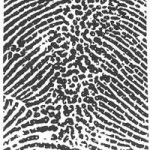
Dissociated ridges (on left) do not look like a form of a pattern that is only missing some details, instead they look somewhat broken and chaotic like modern day QR Scanner Coding.
“Vestiges: Erratic local disarrangements of ridges not conforming to surrounding ridge formations.” David R. Ashbaugh “Quantitative-Qualitative Friction Ridge Analysis” (1999)
Another type of a vestige is formed by a group of local sharply converging ridges. These are not to be mistaken for what is known as ‘multiplication’ in the ridges. Multiplication is formed by a group of ridges that narrow down and fan out as they cross areas of the hand illustrating the contours in the fetal stage at the time of formation. The most common example of this formation is in the area between the heart and head lines.
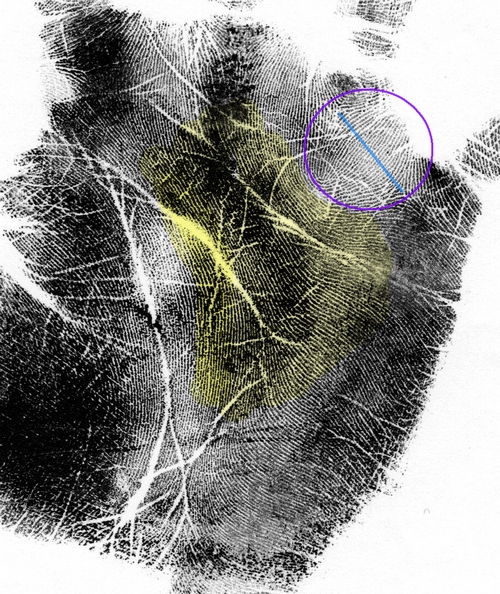
“The increased width of an interdigital area at and near the level of the digital triradii is associated with curvatures of ridge course and with multiplication of ridges; multiplication of ridges signifies a greater number of ridges at a level of increased width of the area. Multiplications of this type are formulated merely as open fields because the multiplication is more or less evenly distributed across the interdigital area, contrasting with a localized region of multiplication wherein there is a concentrated spraying of ridges.” Cummins & Midlo “Finger Prints Palms & Soles”
Notice in the print above how the ridges increase at the widest point in the interdigital area (circled in purple). This is normal multiplication of the ridges that illustrates the increase in the size in this area. It’s important to note that the multiplication is evenly spread across the entire interdigital area.
The highlighted area in yellow shows the typical pattern for multiplication of ridges flowing across the upper middle of the palm. Notice how they narrow down near and between the head and heart lines. The ridges also tend to become finer and closer together in this area as well as becoming courser and wider apart as they spread out. Multiplication of ridges is a normal but interesting aspect of Open Fields.
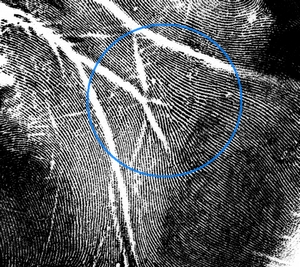 On the left, another example of Multiplication of Ridges shows how the narrow channel of ridges fan out and widen from the center of the palm toward the outer side of the hand. Beryl Hutchinson, in “A Modern Guide to the Art of Palmistry” (1967), wrote”As the Open Field ridges pass under the third finger area they may open into an onion shape thus making the graining much finer”.
On the left, another example of Multiplication of Ridges shows how the narrow channel of ridges fan out and widen from the center of the palm toward the outer side of the hand. Beryl Hutchinson, in “A Modern Guide to the Art of Palmistry” (1967), wrote”As the Open Field ridges pass under the third finger area they may open into an onion shape thus making the graining much finer”.

Below is an example of a rapid convergence of ridges with a “concentrated spraying of ridges” approaching a loop, in a localized zone (Vestigial Loop). This is from the book “Friction Ridge Skin: Comparison & Identification” James F. Cowger (1983)
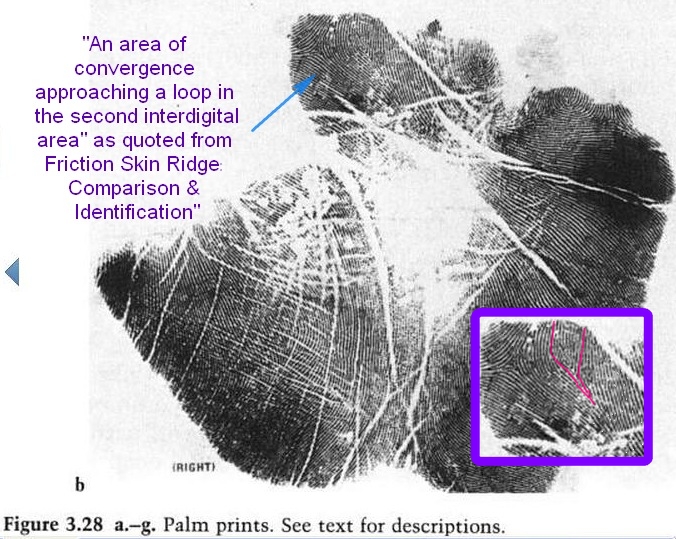

Converging ridges are an aspect of multiplication, so they can be easily mistaken for each other. The important thing to remember with converging ridges as a vestige is that they are localized, rapidly converging, quickly fanning apart or coming closer together, and reducing or increasing in number. In the interdigital areas these vestigial formations are not typically evenly spread across an entire zone, but instead would be clustered in a section. Between the index and middle fingers this is common closer to the index finger side and between the little and ring fingers it is more commonly found closer to the little finger. The latter is the most common area for this formation to occur.
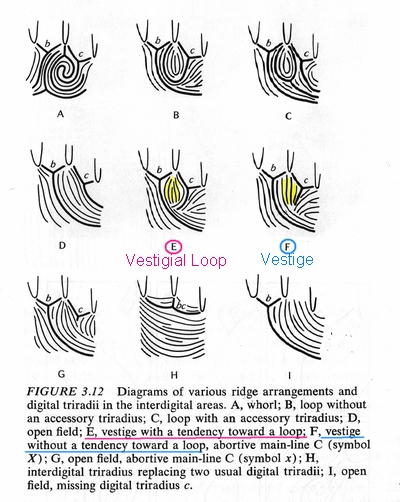 Schaumann & Alter “Dermatoglypics in Medical Disorders”
Schaumann & Alter “Dermatoglypics in Medical Disorders”
“Ordinarily a vestige is merely a local disarrangement of ridges which converge abruptly” Cummins & Midlo “Finger Prints Palms & Soles”
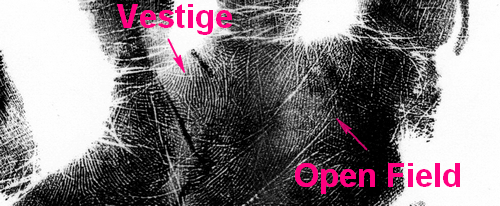
In the above example the interdigital zone between the index and middle fingers shows smoothly flowing ridges that gently fan out. This is called an Open Field in dermatoglyphics. Between the middle and ring fingers it is obvious that there is some kind of disturbance to the otherwise smooth flow of ridges. At first glance it appears to be an interdigital loop. In the close up below you can follow the purple lines that consist of a series of rods that converge and meet. For this to be a true loop it would require at least one clear recurving ridge that isn’t made from the main line (or radiant) of a triradius. (here main line B under the middle finger). Rod-like ridges that meet do not qualify for a recurve as ridges do not curve at such tight angles, they touch and merge. If a formation is present that is too obvious to ignore, researchers make note of its loop-like nature by describing it as a vestige or vestigial loop.
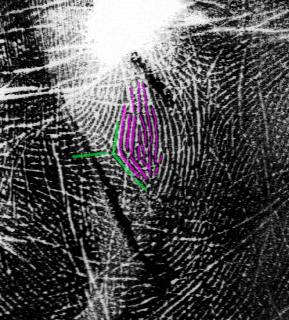
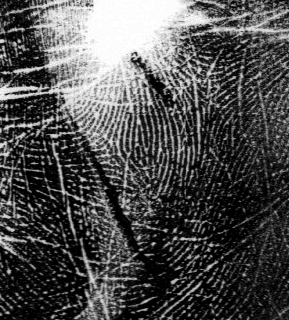
Another form of converging ridges results in shapes that range from a fan to a comb. Some of these are very distinct patterns, but do not conform to the guidelines of the familiar formations such as the loop, tented arch, and whorls. These configurations are all categorized as vestiges. Some vestiges are ignored in classifications, including patterns that are transitional between one type of pattern to another. For example, a loop pattern fingerprint must have 3 characteristics to qualify as a true loop. It must have at least the following details as copied here from “The Science of Fingerprints” US Dept of Justice. If one characteristic is missing it becomes by default a tented arch pattern. These rules make sense because they follow the underlying aspects involved in the development of ridges in the fetal stages.
“In connection with the types of tented arches, the reader is referred to the third type. This form of tented arch, the one which approaches the loop, may have any combination of two of the three basic loop characteristics, lacking the third. These three loop characteristics are:
● A sufficient recurve.
● A delta.
● A ridge count across a looping ridge.”
Walt Disney had one of these patterns that fails to conform to all the requirements of a loop and thereby becomes a tented arch. These types of patterns in transition have for decades resulted in passionate discussions and disagreements between researchers as they can look so much like a pattern but yet lack minute but important and required detail. It is best to recognize them as vestiges that are incomplete patterns or patterns in transition.
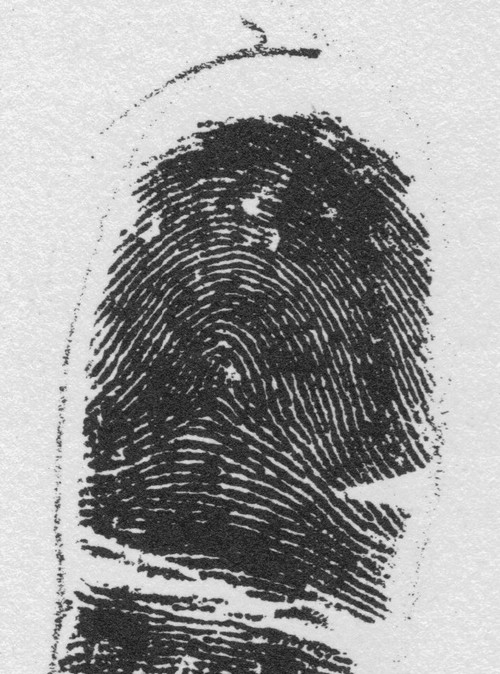
In the close-up on the right copied from “Lion Paws” by Nellie Simmons Meier, it is obvious that there are sharp angles and a lack of a distinct recurve. The lack of a recurving ridge results in a tented arch. A central triradius is also seen. A triradius is a location where three fields of ridges meet forming a small triangle called a Delta, or a Y shape formation, with nearly equal 120 degree angles.
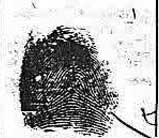
The US government marked Disney’s fingerprint as t with a \ showing it is classified as a radial tented arch. Although the quality of the photo copy gives an appearance of a loop, it would be a vestigial loop resulting in the classification of a tented arch.

(from “Dermatoglyphics: An International Perspective”)
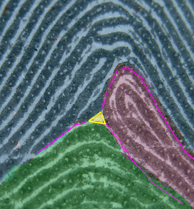
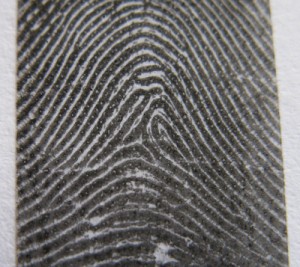
This is a fingerprint sample of a vestigial loop configuration from a friend showing a unique and interesting arrangement of ridges that results in a tented arch classification. There is a delta or triradius (colored in yellow) and three fields, but here based on the US Dept. of Justice’s guidelines for classifying a loop there is a lack of a ridge count. This is because the outline of the loop formation is formed by the radiants from the delta or triradius. The remaining ridge at the core appears also to loop, but it does so at a sharp angle meaning it is quite likely two rods meeting and merging, one curved and the other more straight.
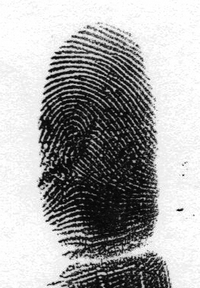 Sometimes ridges can be so unique to the point that patterns can appear superimposed over one another. Here a loop is entering from the radial and the ulnar sides of the fingertip. Normally this would result in what is called a twin loop (also called a double or composite loop). This is where the loops can be traced entering from either side and usually they entwine. A lateral double loop involves two loops that can be seen to enter from the same side.
Sometimes ridges can be so unique to the point that patterns can appear superimposed over one another. Here a loop is entering from the radial and the ulnar sides of the fingertip. Normally this would result in what is called a twin loop (also called a double or composite loop). This is where the loops can be traced entering from either side and usually they entwine. A lateral double loop involves two loops that can be seen to enter from the same side.
In this sample, you can trace each loop continously even though they overlap. I would call it a vestigial twin loop, it fails to meet the requirements of a double or true twin loop. There appears to be a second triradius between the two loops at the top where three fields are meeting.
In order to recognize what a vestige is, one should become very familiar with what qualifies as a pattern. These include the whorls and their subcategories. Various nomenclature is used by different researchers for composite loops (double, twin, lateral) and patterns with 2 or more triradii. The FBI felt that tracing out the details of these composites was too time consuming and complex to separate them into the individual categories they deserve. There are radial and ulnar patterns coming in from different sides of the finger, loops, tented arches and arches. Classification of prints is different than interpreting the prints in a reading. For example, an incomplete or vestigial double loop, because of invalid cores, becomes classified as a whorl, but in hand analysis the obvious nature of the two groups of ridges entwined is much different than a plain whorl with concentric or spiraling ridges.
Full details on how to classify fingerprints can be found at this link: The Science of Fingerprints
If this is a subject that fascinates you as it does me, I’d highly recommend you spend time studying these guidelines and the multitude of fingerprint samples at the above link. There are differences in finger print science and terminology between the fields of forensics and biology. They use different terms for the same thing at times which can be confusing at first. Forensics is interested in identification, and biology is focused on human development, structure and function. Hand readers bring in the field of psychology with comparing behavior and cognizance to the various patterns and combinations.
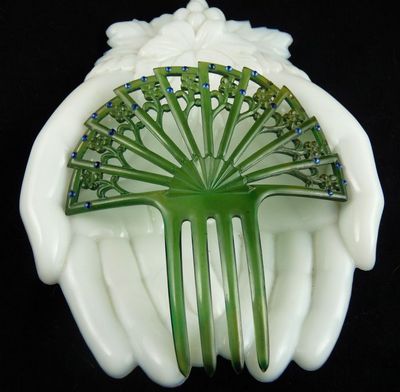
So, how to recognize a comb or a fan in the hand…
My inspiration and the catalyst for this article came from an appreciated frequent responder to my posts. He recently shared a print from an interdigital area that is very similar to the print on the left below and asked about the shape that was noticeable in what would otherwise be an open field (on the right).
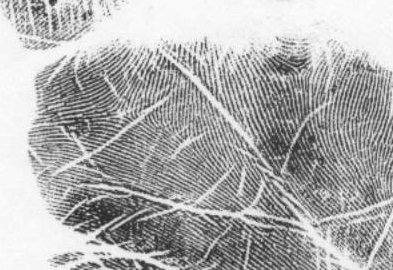
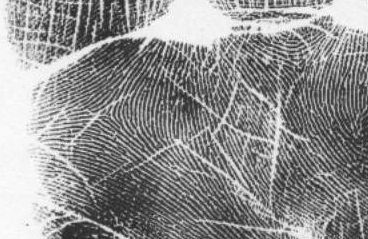
Although the differences in the details are subtle and easier to see with a trained or practiced eye, there are indications in the flow of ridges in the left sample to indicate that a hint of a loop with an accessory triradius is present. The sample on the right is an open field without any disturbances interdigitally.
The screensave below from Google books shows a quote from “Dermatoglyphics: An International Perspective” edited by J. Mavalwala. Here the concept of an accessory triradius that is vestigial is mentioned.
 The requirements of a triradius are described in “Dermatoglyphics in Medical Disorders” Schaumann & Alter as follows: “A triradius is formed by the confluence of three ridge systems (Figure 3.5). The geometric center of the triradius is designated as a triradial point. Ideally, the triradial point is the meeting point of three ridges that form angles of approximately 120 degrees with one another (Figure 3.5A). However, if the three ridges fail to meet, the triradial point can be represented by a very short, dotlike ridge called an island (Figure 3.5B) or by a ridge ending (Figure 3.5C), or it may lie on a ridge at the point nearest the center of the divergence of the three innermost ridges (Figure 3.5D) Sometimes, the triradial point does not lie on a ridge and is determined as the point where the three angles between the innermost ridges are each as near as 120 degrees (Figure 3.5 E,F).”
The requirements of a triradius are described in “Dermatoglyphics in Medical Disorders” Schaumann & Alter as follows: “A triradius is formed by the confluence of three ridge systems (Figure 3.5). The geometric center of the triradius is designated as a triradial point. Ideally, the triradial point is the meeting point of three ridges that form angles of approximately 120 degrees with one another (Figure 3.5A). However, if the three ridges fail to meet, the triradial point can be represented by a very short, dotlike ridge called an island (Figure 3.5B) or by a ridge ending (Figure 3.5C), or it may lie on a ridge at the point nearest the center of the divergence of the three innermost ridges (Figure 3.5D) Sometimes, the triradial point does not lie on a ridge and is determined as the point where the three angles between the innermost ridges are each as near as 120 degrees (Figure 3.5 E,F).”
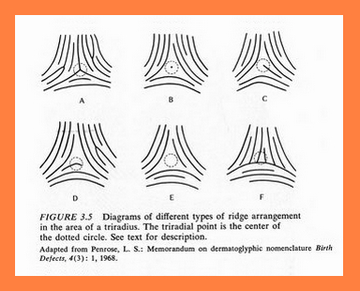
Mavalwala gives his description of vestigial in “Dermatoglyphics: An International Perspective”. Here is another screenshot:
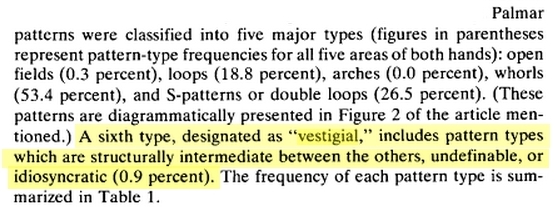
If we think in terms of a pattern that is “undefinable or idiosyncratic” and doesn’t conform to the conventional definitions of a pattern, then a Vestigial Triradius would be a configuration that doesn’t meet all the requirements of a triradius, but has enough of them to suggest a triradius in a degenerative or incomplete form. In the sample below, there is a shape much like a triradius contained within the blue circle. There is a place where two fields of ridges part ways and the space between the Y shape formation consists of converging ridges that appear like a failed loop or more like a comb pattern that consists of rods of ridges meeting a crossing ridge to appear like a hair comb. I would call the pattern below a vestige of a comb containing a vestigial accessory triradius.
A comb itself could be considered a more structured formation rather than a degenerative pattern as it can be formed by a distinct group of rods butting into a group of ridges flowing in a different direction and contained in its own space. The examples below would be something ranging from a fan and to a comb between the middle and ring fingers. Notice how the rods all end abruptly along the same plane. The formation between the index and middle fingers is a loop with an accessory triradius. Notice its resemblance to the vestigial comb shown above. If the recurving ridges, and I think there is only one that counts, were missing on this loop below, it would become a comb because it is mostly rods. It’s difficult to see, but there is a tiny comb like formation at the triradius of the little finger, too.

The obvious band of ridges running under the middle and ring fingers are considered a sign of a mild webbing of the digits at the time of dermatoglyphic formation. This is called zygodactyly.
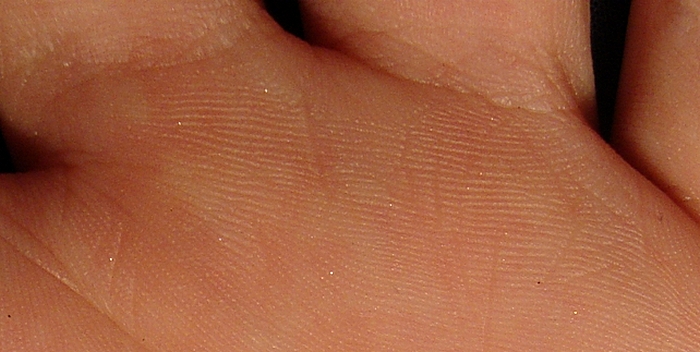 Above is another example where the ridges interdigitally fill the area with ridges flowing in a different direction. The pattern is distinct and is a type of vestige that is referred to as a comb or a fan. Schaumann & Alter mention the comb in a section of their book about minutiae. Minutiae is described as “numerous irregularities of direction, discontinuities, and branchings of individual ridges… These intricate details of ridge structure, termed minutiae by Galton (1892), are highly variable and their number, type, shape and position are unique to the individual.”
Above is another example where the ridges interdigitally fill the area with ridges flowing in a different direction. The pattern is distinct and is a type of vestige that is referred to as a comb or a fan. Schaumann & Alter mention the comb in a section of their book about minutiae. Minutiae is described as “numerous irregularities of direction, discontinuities, and branchings of individual ridges… These intricate details of ridge structure, termed minutiae by Galton (1892), are highly variable and their number, type, shape and position are unique to the individual.”
“A comb is a ridge formation in which three or more parallel ridges join another ridge almost at right angles to their direction of flow.” Schaumann & Alter “Dermatoglyphics in Medical Disorders”
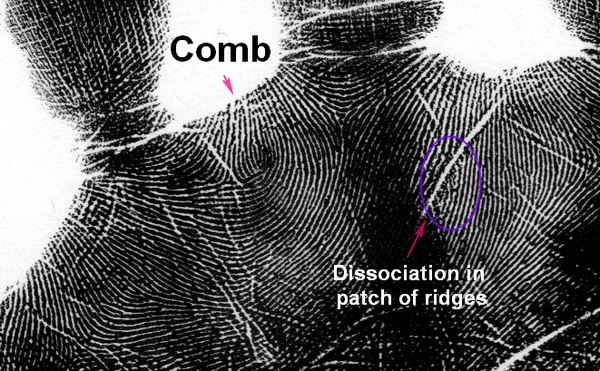 The comb formation above is formed by the radiant (main line C) becoming the ridge that appears to form a recurve but doesn’t. There is no loop, but simply a small group of rods coming to a dead end at almost right angles. Notice the disturbed ridges by a crease, these are called dissociated ridges as they do not flow in smooth rows but have instead become chaotic.
The comb formation above is formed by the radiant (main line C) becoming the ridge that appears to form a recurve but doesn’t. There is no loop, but simply a small group of rods coming to a dead end at almost right angles. Notice the disturbed ridges by a crease, these are called dissociated ridges as they do not flow in smooth rows but have instead become chaotic.
The sample below has several unusual and rare dermatoglyhic interdigital configurations. A loop called a raja loop is typically what is found in the second interdigital area when a pattern forms there. Occasionally this loop flows into other parts of the hand. Here it has flowed over to between the ring and little fingers in interdigital IV area. Rod like ridges are stopped from flowing by the curving ridges in the loop. These 4 or 5 ridges form a small vestige. There is also a third pattern in interdigital IV zone, a long loop that swoops under the ring finger. This feature has the nick name of the Vanity Loop. People with it are very self aware, and conscious of themselves, especially physically. Perhaps this natural self awareness makes them seem too self interested to others hence the given name.
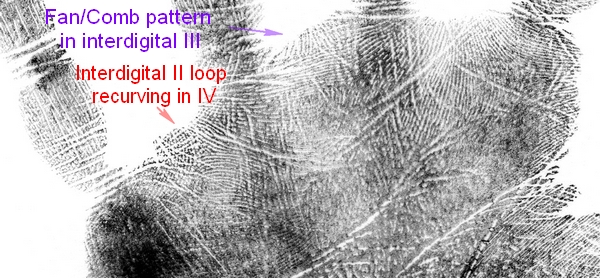
 Above, in the Interdigital III zone, vertical ridges are trapped by horizontal ridges flowing under the fingers. This creates the formation that is like a fan or a comb. Choosing between a fan and comb pattern can be subjective, depending on what kind of fan or comb a person visualizes and how they interpret what they are seeing in the ridges. Sometimes they may even take on the appearance of seashells. These are not conventional patterns that follow exact guidelines, instead they can be the opposite, as they fall outside of established guidelines and are unique to the individual.
Above, in the Interdigital III zone, vertical ridges are trapped by horizontal ridges flowing under the fingers. This creates the formation that is like a fan or a comb. Choosing between a fan and comb pattern can be subjective, depending on what kind of fan or comb a person visualizes and how they interpret what they are seeing in the ridges. Sometimes they may even take on the appearance of seashells. These are not conventional patterns that follow exact guidelines, instead they can be the opposite, as they fall outside of established guidelines and are unique to the individual.
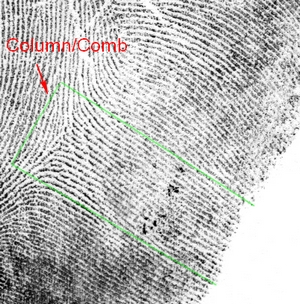
Recently I came across a report on the internet about classifications of thenar and hypothenar patterns. The pattern referred to as a comb among some hand analysts, was described as a column. I agree with column for this pattern on the right. This matches Fig. 3.5F in the illustration above from Schaumann & Alter and although there is a hint of two triradii, one on each side of the bottom of the column where the ridges fan out, the triradius should be located nearer to the center. This could also be described as a vestige of a tented arch on the hypothenar missing the ridges curving over the ‘tent pole’.
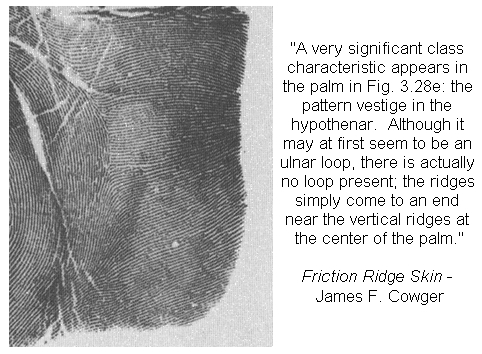
Below is an illustration from Cummins & Midlo’s “Finger Prints, Palms & Soles” showing the varieties of patterns found on the hypothenar mount. This area covers several territories in palmistry, commonly referred to as Ulnar Mars, Lunar, and Pluto. The formation in the example above appears to be a cross between the three examples outlined below, but lacking the recurves of the loops, while containing several rods which end at almost right angles.
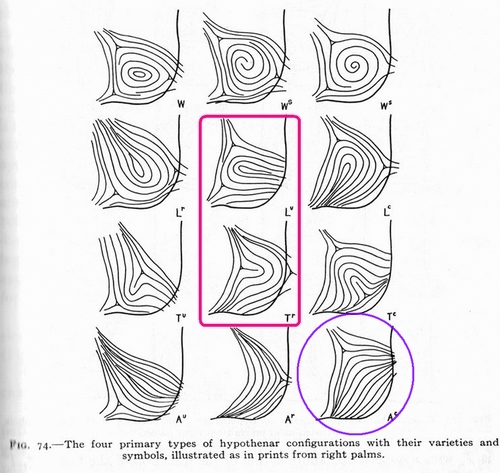

Columns and Combs are basically the same thing. The comb has been referred to in the medical texts and column is the term used in forensics. They are typically a vestigial loop without recurving ridges, with several parallel rod-like ridges meeting a field of ridges from another direction. In the thenar area, between the life line and the base of the thumb, the angles are sharper and closer to appearing at right angles. In forensics, if a palm print is found with a squarish pattern, it is considered most likely from this area. Other areas of the palm are subject to different tensions during development. The little and index fingers have a wider range of movement outward than the middle and ring. The hypothenar is the most fixed part of the palm without a digit to provide tension.
The palm is flexing and bending during the second trimester of pregnancy when the ridges are developing. Because of the different surfaces, the angles can range from an appearance of sharp almost right angles, to arched curves, to diagonal angles forming a seam appearance. Combs, columns and seams are all forms of vestiges that are found within open fields.
Vestige Samples
On the left below is a small comb-like vestige interdigitally in a person’s left hand and on the right is the same person’s right hand for comparison.
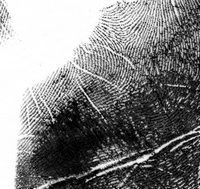
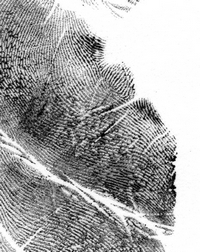
Below are right and left hand prints from the same person with very unusual ridge formations. See notations on the images for fans, combs and loops.
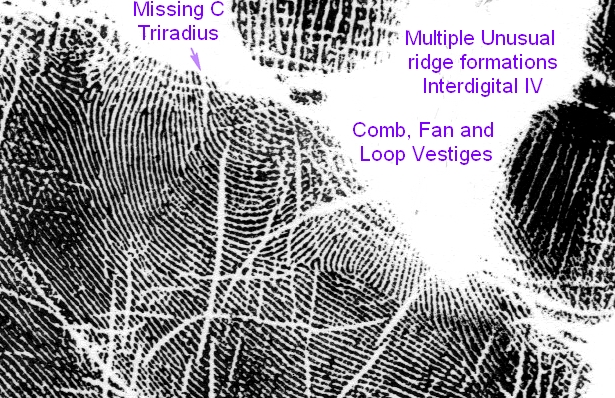
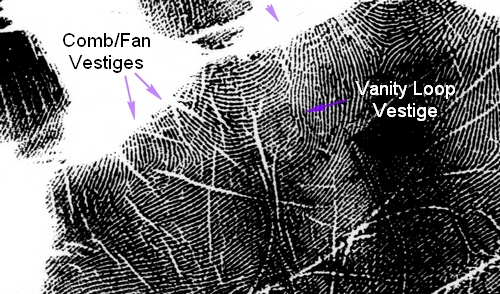
According to Danuta Loesch in “Quantitative Dermatoglyphics” (1983), these seam formations develop on surfaces of the palm where there is a quick change from elevated to a valley below. Like a sudden drop-off or a cliff. From a mathematical perspective the ridges follow rules regarding convex and concave terrain in their formation. The seam would be illustrative of the sudden change in the ‘handscape’ in a localized territory.
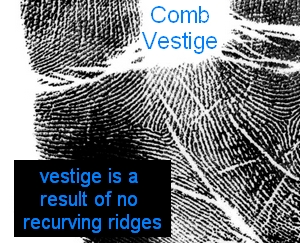 This vestige is a result of the radiant from the triradius being the only ridge that encloses a group of rods. Because of this there are no recurves and therefore no loop although there is an accessory triradius.
This vestige is a result of the radiant from the triradius being the only ridge that encloses a group of rods. Because of this there are no recurves and therefore no loop although there is an accessory triradius.
In the left hand in the prints below you can see a very large loop that fills the interdigital zone. In the right hand there is a very small disturbance in the ridges giving the impression of a pattern, but none is there, only a small localized patch of converging ridges forming a vestige.
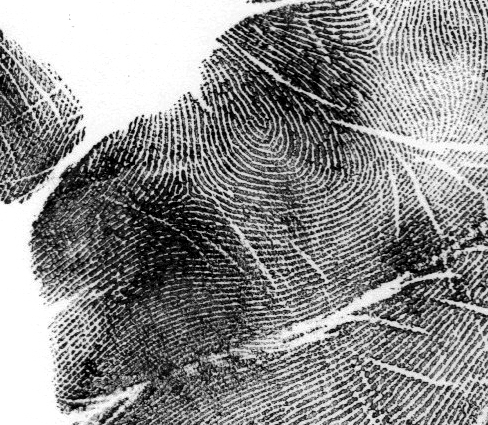
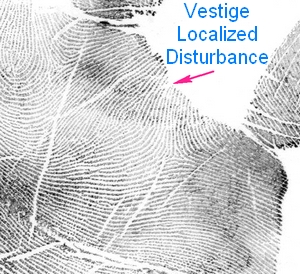
In some traditions of palmistry this vestige of a pattern on the above right print would be seen as a shape resembling a small eye in the palm. Peacock Eyes (Central Pocket Loop) on the fingertips, and whorls on the palms or fingers are considered to be associated with eyes and chakras. Portals to and from the inner and outer worlds. Eyes in the palms, in folklore, are thought to bring protection from the evil eye.
The fingerprints below are the right and left middle fingerprint. At first you might want to think that you’re looking at a scar, but look more closely at the black lines and you can see the lower ridges curve back around individually where they bump into the ridges flowing over the top. The left hand fingerprint is a double loop which is what it looks like this fingerprint was trying to be. This would be classified as a whorl because it is only a vestige of a double loop and there are two triradii.
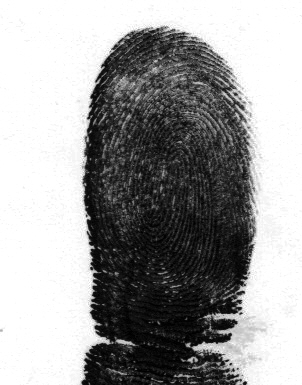
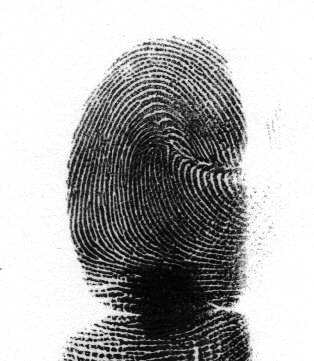
Compare the chevron formation below with the pattern on the thenar mount at the beginning of this article. Notice also the unusual joining of the heart line with the fate line. Obviously something unusual was happening in the palm during the fetal stages of development.
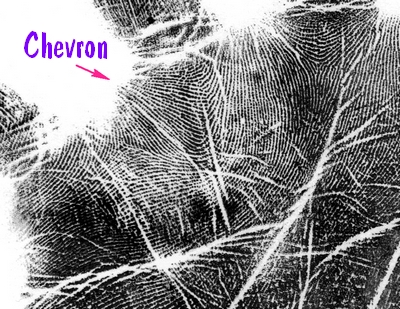
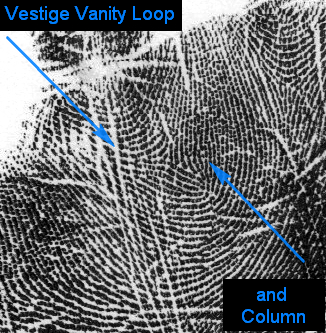
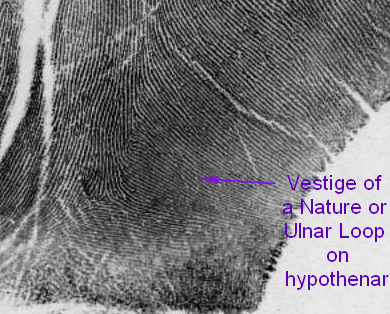
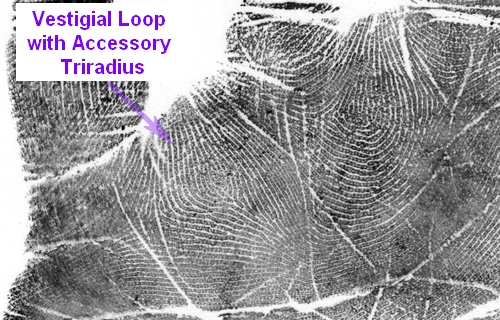
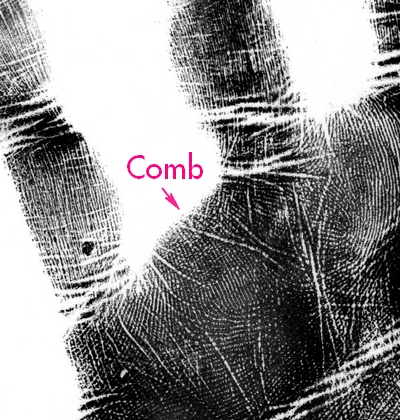
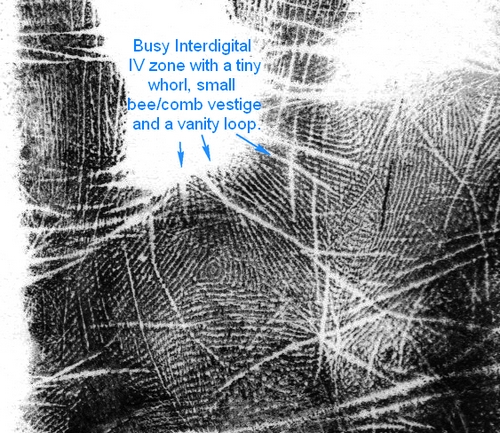
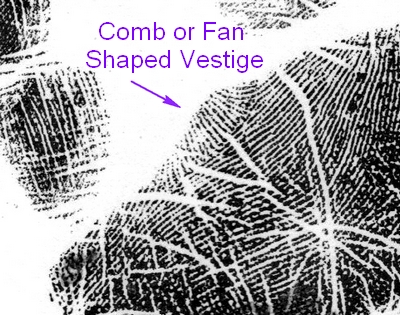
“Vestiges may be defined as a local disarrangement in a parallel system of ridges.”
“Quantitative Dermatoglyphics” Danuta Z. LoeschVestiges as you can see come in many shapes and sizes and are as individual as the person on which they appear. In “Trends in Dermatoglyphic Research” (screensaved below from Google Books) the author points out that it’s difficult to assign values in coding systems for intensities because there is “a considerable amount of subjectivity” involved. This means that one researcher may describe a vestige in one manner and another would describe it differently as the vestige may have features of both configurations or be a one of a kind.
There is also some confusion about whether a vestige is a pattern or an open field. They are classified with open fields because they are not usually distinct enough to be described as a singularity or pattern. They are considered the minutiae of open fields. They are not, however, an empty open field and should not be mistaken for such. The dermatoglyphic surface area is divided into open fields and patterns. If it’s not one, it’s the other.
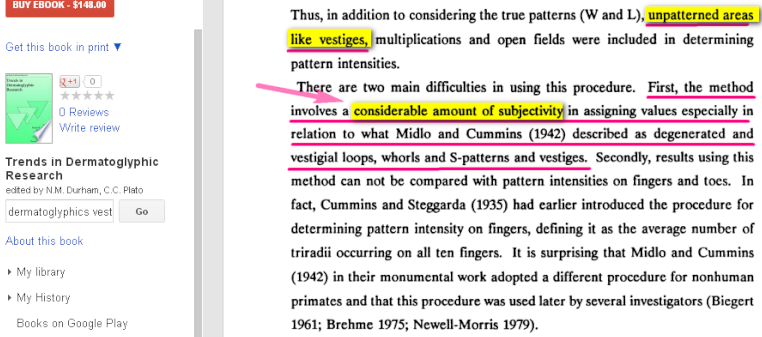
Lionel Penrose, a mathematician, explained the mathematical mechanics behind the movement and flow of ridges across the palms, soles, fingers and toes. Understanding the natural course of ridges helps to understand how patterns come together along with the insight to recognize the differences between vestigial patterns, vestiges and true patterns.
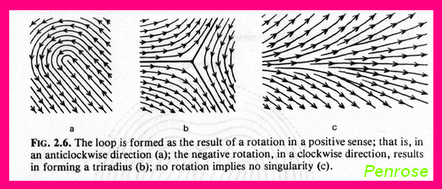
Want to test your knowledge on dermatoglyphics (also known as friction and skin ridges)? Click on the image below:
Looking through my collection of prints from a multitude of sources, I began to notice a trend. The vestiges were found on the most colorful and unique individuals in the groups of samples that were of people that I know. They are people with extraordinary abilities and unusual interests. As unique and special as their prints.
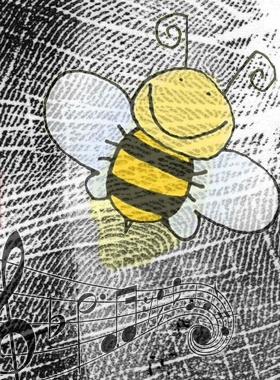
If you have an unusual print you are curious about please feel free to upload it at one of my Facebook Pages for discussion! Please *like* them too!
I would love it if you’d share the link to the article with your network of friends that may have an interest. If you copy and paste anything, please be sure to acknowledge me as the author and this link as the source. Thank you!
Your replies are welcome below!
in joy and peace,
Patti Lightflower

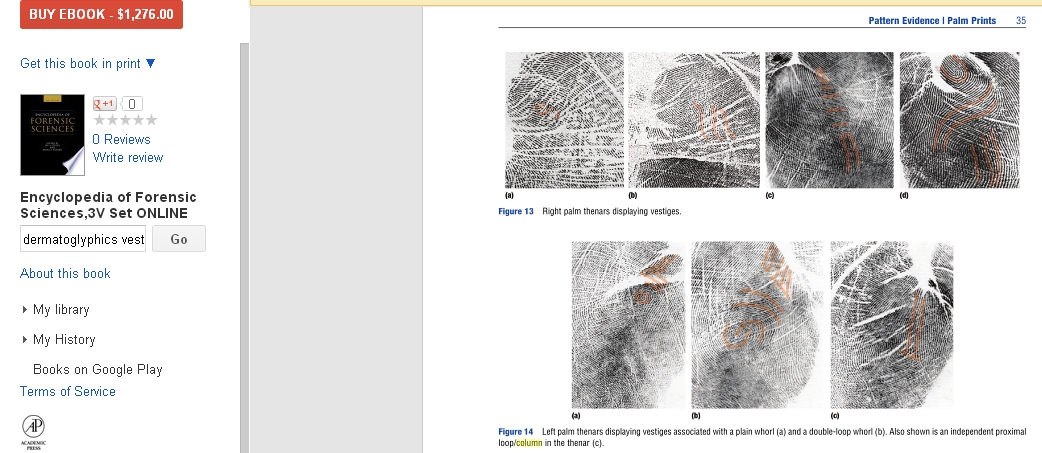
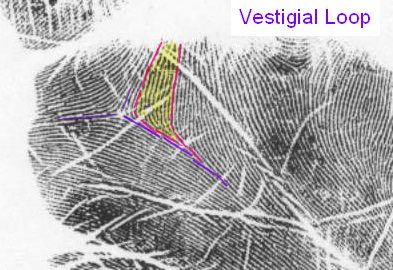
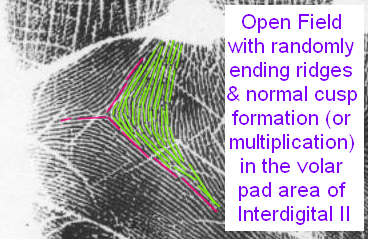
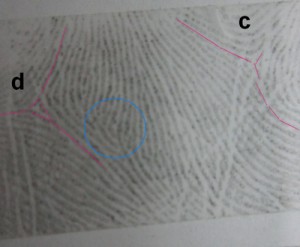
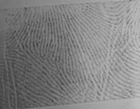
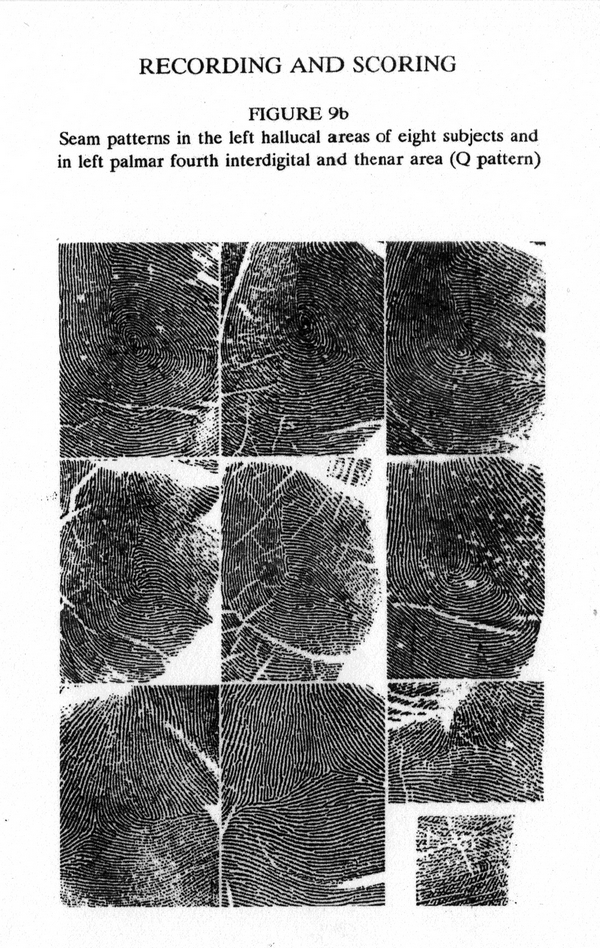
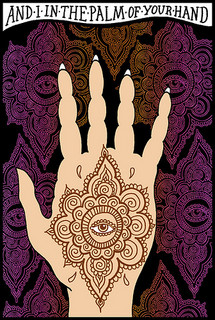
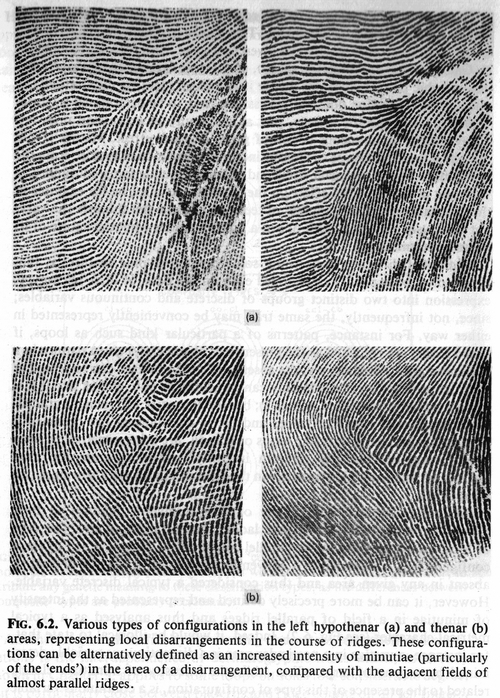
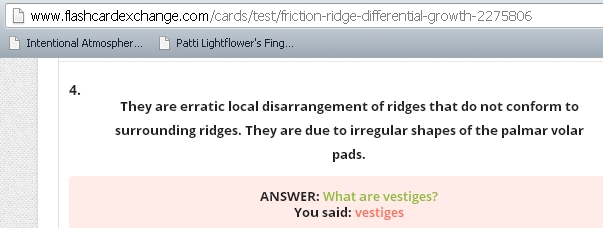
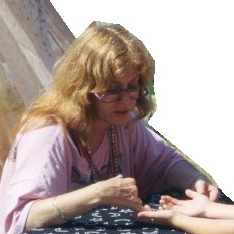

Hello Patti
Great information, lot of hard work done from your side to provide such valuable information for learners like me. Iam getting my confusion clarified here, Interesting thingh about vestige and other similar patterns. The multiplication of ridges is interesting, I will post one print which I have not sure whether it is a vestige, but it is on the hypothenar, plain of mars area, I will post it this weekend I don’t have the pics right now.
It is also interesting to see whether the main line index A position has any role to play on multiplication of ridges, from the picture you have posted the main line index A flows down to the hypothenar I think it is number 3 position.
Anand
Thanks Anand!
I have been observing the relationship of the main line A and the major creases.
Each side of the main line normally would represent a different field, however sometimes this main line can come to an end in the palm in the center of a loop and then the field would extend around to both sides of the main line like a tented arch.
Multiplication is more based on the contour of the palm. The ridges are fanning out to cover a rising and widening area or converging in to fit into a tighter more narrow zone. The onion comparison is a good one from Beryl Hutchinson.
Hello patti,
I have been searching for this details for many years. I read few books on this topic. Certainly i am not sure that i know the differences of each type of dermatoglypics. Some websites are explaining it so vague. But, After reading your research article, i get much better idea. Thank you patti.
Thank you Janilia, I really appreciate your feedback!
Dear Patti,
What a fantastic research you have done great compliments. The study of dermatoglyphics is complicated. I also have a large document made on this subject. Many of your prints I also know and are soon in my new book this summer. Yours interpretation is more logical than the dermatoglyphics in Paul Gabriel Tesla’s book “Crime & Mental disease in the hand”. Thank you to share this with us.
With love Magda ,
School of Universal Handanalysis/Palmistry, the Netherlands
<3
Dear Magda,
Thank you so much for taking the time to read my article! Your complimentary reply is something I value very much and is so encouraging to me.
Also, thanks for mentioning Tesla’s books, I will have to look for a copy. Is your work in English?
blessings and much love,
Patti
p.s.:
Looked up Tesla at Amazon and realized he is the one who offers a false image for Bundy’s hand. Ted Bundy actually has a very strong hand with good features, not the one he has used. I actually posted a question to the author in February of this year asking him about his source for his print, (and then forgot about it) but I see there still is no reply.
I wrote:
Ted Bundy’s Hand Print – Is It Authentic?
In videos and photos it is noticeable that Ted Bundy’s little fingers are straight in both hands. Could the author explain how the printing process was made to result in a curving finger that appears to have clinodactyly? Was the outline made while the hand was still attached to the paper or was that traced for the purpose of the book? The thumb print appears inserted into the outlined hand.
Patti,
Out of curious, I would like to know that how much it helps to understand a person in palmistry? Can we predict anything about the person if we read this details ? or it represents the disposition of the person . and any other use?
Hope that you will explain it in detail.
Thanks.
Hello Mani,
I don’t think they can ‘predict’ anything. The dermatoglyphics form before birth and their pattern is permanent with any changes being due to break down with health, age or scarring.
I think they represent how we are wired via the nervous system. The ridges also relate to the sense of touch and can be associated with our abilities to be consciously aware in our environment.
More complete patterns, such as a whorl or loop in the hypothenar (lunar) area are associated with how people remember things, in particular visual or photographic memories.
There is too much to describe in a reply here, but I’ll make a note to write about the other dermatoglyphic patterns found in the hands in the near future. I do appreciate your interest!
🙂
Thanks patti,
But i did not understand the worth of identifying these ridges in palmistry?
We identify the formation or type of ridges. That’s all. ( Unlike reading life lesson/purpose where we explain about the client/sitter’s in detail. ). Forensic medicine does the same about identifying and classifying ridges. but what is the purpose of it in palmistry??? I am still confused.
For me, it’s not enough to memorize a bunch of meanings for a list of configurations. In a life purpose reading based on fingerprints, you are trusting that the system actually works without knowing why.
I have always been curious about how things work and since a child have taken things apart to see. With hands, I have studied limb development to understand the mechanisms behind why I and others can so accurately describe a person’s behavior and motivations. For me, this journey of discovery has been very enlightening and I think it has made my readings more real and even more accurate.
Check out the link above under Palmistry/Science for Star Delta Triradii. The information I’ve included there shows how the ridges are literally wired to the brain, heart and other major organs. The communication is two ways. In the hands we read about our current emotions and how we have built shields of protection that may sabotage our efforts. What we are reading are the additional markings that appear there as a result of our experiences and reactions. Our personality type shown by features in the hands combined with our habitual way of doing things, plus these markings showing our reactions to experiences, are combined to get an idea of how a person proceeds into the future with their lives.
What a brilliant article, Patti! I love your in-depth, scientific approach and finally have the feeling that I ‘get’ what vestiges are all about. Thank you so much! Also chuffed that one of my prints is famous now. 😉
Thank you Romy!! Love the word “chuffed” (had to Google it, of course) 🙂
do you think that ridges around any tri-radii can be called vestige? just curious!
The triradii are not related to a vestige unless it is part of the vestige. The meaning for the word vestige is a remnant or remainder of something that is not yet or no longer visible. In the dgs, which are permanent once formed, there is no continuation of this vestige to a better or lessor form. It is what it is. Since it is more than an empty open field and less than a pattern, the name vestige was applied.
I have shared a variety of vestige formations here. There is no limit to their possibilities nor is there a formal description with exact criteria they must meet. That’s why they are vestiges. Some frequently found vestiges do have descriptions, like combs, but in general they are simply incomplete formations or some kind of obvious disturbance in the flow of the ridges. They do not have to have right angles or be associated with a triradius.
Hi patti
An interesting thingh I was looking at Einstein hand print and it looks like there is a vestige pattern in his right hand in the mercury mount, I think it looks like comb to me http://www.dermatoglyphics.com/einstein/
Anand
I don’t know, the image looks too pixelated on my screen to say.
🙂 I found better prints!
http://www.ireadhands.com/blog/archives/941
So, It is so common to find vestige in palm. What is the general meaning of vestige if found in hands?
Thanks.
Yes, vestiges are very common. As to their significance, I would look at a couple of things. The location of the vestige and the timing of the development of that area of the palm. If that timing was able to be correlated to other aspects of anatomy developing at the same time, they could possibly be tied together.
In a reading I like to refer to them as possibly relating to a quirk or idiosyncratic behavior relative to the area found. The ones that are obviously fragments of a pattern such as a loop or whorl, I think these would have less significance than the indications applied to a complete pattern. As they are often unique, it would require not only reading them in context with the other features, but it would be good to have a dialogue with the owner for feedback.
Patti, what is the general meaning of “comb” in palmistry? I think that i have comb in my moon mount. 🙂
Same answer as your earlier question.
Hi Patti
In fig 6.2 a is that a vestige, but where should i look at triradius, i guess i have a similar one like that, i will see whether i can take an pic and show it you. Is the triradius the converging point of the ridges.
Anand
It’s not being described as a triradius by Loesch, but instead a local disarrangement or rapid convergence. There doesn’t appear to be 3 fields involved as required for a triradius.
Hi Patti
So i can call it as vestige. Yes sometimes when you look closely it looks like there is some kind of triradius but cannot be categroized fully as triradius.
Anand
Hi Patti
It looks like in calcualtion of total number of triradii for a palm when vestige are involved is a question which is yet to be answered correctly like you cannot say it is 1 nor can it be said zero. That makes this more interesting in knowing how to go about. Mysteries happen when rules cannot be defined, there is mystery in vestiges, hope this can be solved to get a clear understanding
Anand
Hi Patti
Do none of the four in fig 6.2 a have a triradius, I was thinking from the picture there is something similar like a looping but converges rapidly where the recurve is sharp (resembling a mountain top), so I was thinking that is one ridge system, the other two are the one above and below it. Iam not able to describe it clearly here, but probably some kind of drawing would help.
Anand
Hi Anand,
In the sample on the left (fig 6.2 a, first set of ridge samples scrolling up), there is a place where you can see the Y shape. This might could be seen as a vestigial triradius. The angles are wide, and there appears to be an almost meeting of 3 ridges. As the ridges spread out between the lower and the left ‘radiant’ there appears to be a seam formation, with several horizontal ridges meeting the vertical ridges and their continued flow being stopped. This is a comb or a column, both are vestiges.
Hi Patti
You can write a thesis on this. Because there is lot of confusion in this vestige area partly because the categorization are difficult, the identification of triradius in whorls and loops are easy but not in vestige is what iam able to see, it requires lot more training, especially hypothenar and other areas there would definitely be confusion on
because sometimes it looks like multiplication of ridges and sometimes not, even if you take prints you have look at hands, then the prints to see where exactly is triradi
us.
Thanks for the clarification, it looked there is some kind of triradius.
Anand
The confusion clears once you understand what to expect of an actual pattern in the sense of a singularity. If you know what the rules are for a triradius, for a loop, an arch, tented arch, and all the whorl types – and then you become familiar with where the expected and normal converging or multiplications of ridges are found – as well as knowing the locations and boundaries of the volar pads (interdigitally and the rest of the palm) — you should then be able tell when you are looking at an unusual arrangement of ridges, odd disturbances in the flow, remnants of a known pattern, and sudden changing of course.
With many things that have an obvious spectrum of possibilities, there’s a gray zone as one thing shape shifts or morphs to something else. That’s where subjectivity allows for personal preference to follow a particular system. Once you understand what to expect in the hands, the various choices of vocabulary and labels shouldn’t be confusing.
Hi Patti
Thanks for the inputs, but sometimes iam able to intuitevely tell or looking at the way the shape is that is similar to a triradius, vestige ect. But definetly this ofcourse has come through by looking at various hands odd patterns and questining what it is. Also reading the FBi book on fingerprints has helped and looking at various pictures, your blog and your input, ect has made me understand a bit on these aspect. Iam still learning so definelty the more i get familiriazed with these rules, i should be able to get it through.
Anand